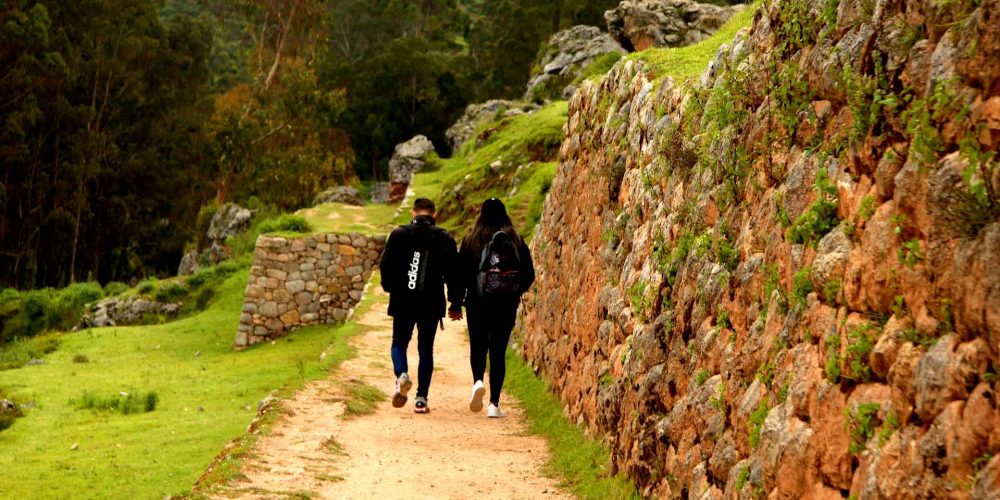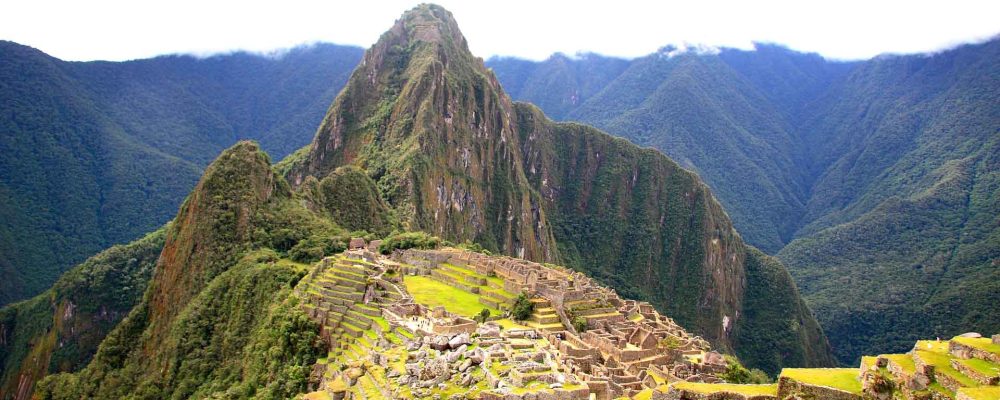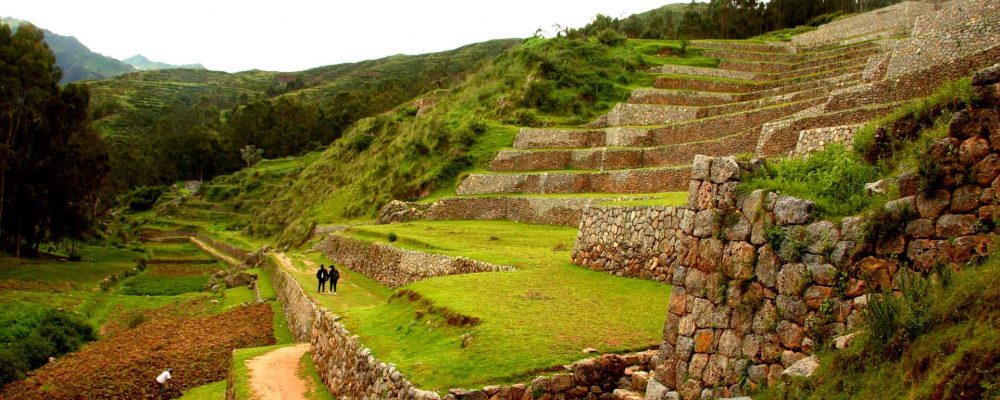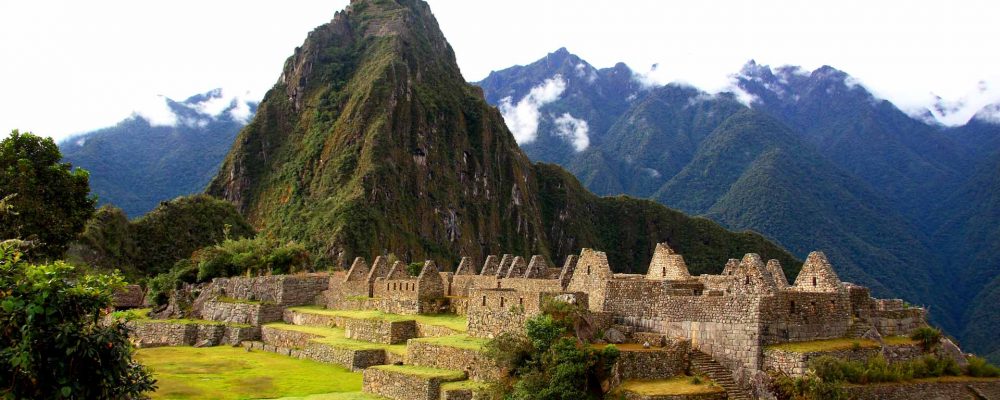Inca Trail
The Inca Trail is an iconic and ancient trekking route that winds its way through the stunning Andes Mountains in Peru, leading adventurous hikers to the awe-inspiring archaeological wonder of Machu Picchu. This historic trail, once a key part of the extensive Inca road system, offers a captivating journey through a diverse range of landscapes, from lush cloud forests to high-altitude mountain passes. Along the way, trekkers encounter well-preserved Inca ruins, such as Winay Wayna and Intipata, providing a glimpse into the rich history and architectural marvels of the ancient Inca civilization. The final destination, Machu Picchu, with its breathtaking panoramic views and enigmatic structures, serves as a fitting reward for those who undertake the challenging yet rewarding expedition along the Inca Trail. The trail not only offers a physical and mental challenge but also an immersive cultural and historical experience, making it one of the most sought-after trekking destinations in the world.

Table of Contents
Overview
The Inca Trail is an iconic and historic trekking route in Peru, renowned for its breathtaking scenery, ancient ruins, and cultural significance. This trail is one of the most popular trekking routes in the world, attracting adventurers and history enthusiasts alike. The trail stretches approximately 26 miles (42 kilometers) and leads to the awe-inspiring Machu Picchu, a UNESCO World Heritage site and one of the New Seven Wonders of the World.
Seasons

Dry Season (May to October): This is the most popular time to trek the Inca Trail. During these months, the weather is relatively dry and stable, with clear skies and minimal rainfall. Daytime temperatures are moderate, making it comfortable for trekking. The nights, however, can be cold, especially at higher altitudes.
Wet Season (November to April): The wet season brings heavier rainfall and warmer temperatures. While trekking during this time can be challenging due to muddy and slippery paths, it offers lush green landscapes and fewer crowds. It’s essential to be prepared for rain and take precautions against slippery trails.
Temperature:
Daytime Temperatures: During the dry season, daytime temperatures along the Inca Trail range from 15°C to 25°C (59°F to 77°F) at lower elevations. As you ascend, temperatures may drop, especially at night.
Nighttime Temperatures: In the dry season, nighttime temperatures can range from 0°C to 10°C (32°F to 50°F), particularly at higher altitudes. It’s crucial to have suitable cold-weather gear for camping.
Altitude:
The Inca Trail involves ascending to high altitudes, with the highest point being Dead Woman’s Pass at approximately 4,215 meters (13,828 feet). Altitude can significantly affect weather conditions and temperature, so acclimatization is essential to prevent altitude sickness.
Microclimates:
The Inca Trail traverses diverse ecosystems, creating microclimates along the way. Hikers may encounter changes in weather conditions, vegetation, and terrain as they move through different ecological zones, from cloud forests to alpine meadows.
Clothing and Gear:
Regardless of the season, it’s crucial to pack layers for the Inca Trail. Lightweight, moisture-wicking clothing is recommended, along with a good quality rain jacket and waterproof gear during the wet season. Sturdy, comfortable hiking boots are essential for the varying terrain.
Planning Considerations:
Before embarking on the Inca Trail, it’s essential to check the weather forecast and be prepared for potential changes. Booking permits well in advance is also necessary, especially during the high season.
Highlights
The Inca Trail is a renowned trekking route in Peru that leads to the majestic ancient city of Machu Picchu. This trek is not only a physical journey through breathtaking landscapes but also a historical and cultural exploration. Here are some highlights of the Inca Trail:
Machu Picchu:
The ultimate highlight of the Inca Trail is, without a doubt, the awe-inspiring Machu Picchu. This ancient Incan citadel is nestled high in the Andes Mountains, and its well-preserved ruins offer a glimpse into the advanced engineering and architectural skills of the Inca civilization.
Scenic Landscapes:
The Inca Trail winds its way through diverse landscapes, from lush cloud forests to alpine tundra. Trekkers are treated to breathtaking views of snow-capped mountains, pristine valleys, and the Urubamba River below.
Wiñay Wayna:
This archaeological site along the Inca Trail is often referred to as a mini-Machu Picchu. Wiñay Wayna features impressive terraces, fountains, and ceremonial structures. Exploring these ruins provides a sense of the advanced agricultural and architectural techniques employed by the Incas.
Dead Woman’s Pass (Warmiwañusca):
As the highest point on the Inca Trail, Dead Woman’s Pass stands at an elevation of approximately 4,215 meters (13,825 feet). Reaching the summit is a challenging but rewarding experience, offering panoramic views of the surrounding mountains.
Inti Punku (Sun Gate):
This ancient gateway marks the entrance to Machu Picchu and is reached after a final ascent on the Inca Trail. Arriving at Inti Punku provides trekkers with a stunning first view of Machu Picchu in the distance, a moment often described as both magical and emotional.
Cultural Interaction:
Along the trail, trekkers have the opportunity to interact with local Quechua-speaking people who live in the high Andes. This cultural exchange adds a unique and enriching dimension to the trek, allowing visitors to gain insights into traditional Andean ways of life.
Flora and Fauna:
The Inca Trail is home to a diverse range of plant and animal species. Trekkers may encounter hummingbirds, orchids, and even the elusive spectacled bear. The trail’s ecological richness adds another layer of fascination to the journey.
Chaski (Inca Trail Porters):
The Chaskis, or porters, play a crucial role in supporting trekkers by carrying equipment and supplies. Their resilience and strength are remarkable, and many trekkers appreciate the opportunity to learn about their culture and traditions during the journey.
The Inca Trail is not just a trek; it’s an immersive experience that combines adventure, history, culture, and natural beauty. Each step along the trail reveals a piece of the ancient Incan civilization and leaves an indelible mark on the hearts of those fortunate enough to embark on this incredible journey.
Daily Breakdown
The Inca Trail is a renowned trek in Peru that leads to the ancient Incan city of Machu Picchu. The journey typically spans four days, covering diverse landscapes and ancient ruins. Here’s a breakdown of a typical daily itinerary for the classic Inca Trail:
Day 1: Start of the Adventure
Early Morning: The trek usually begins early in the morning from the town of Ollantaytambo, with trekkers taking a bus to the starting point at Kilometer 82.
Morning Hike: The first day involves a relatively gentle hike, passing through the lush Sacred Valley. Trekkers walk along the Urubamba River, enjoying beautiful views and gradually acclimatizing to the altitude.
Afternoon Arrival: The first campsite, Wayllabamba, is reached in the late afternoon. Here, trekkers have the chance to rest, enjoy a warm meal prepared by the support staff, and take in the breathtaking scenery.
Day 2: The Challenge Begins
Early Start: Day 2 is considered the most challenging. Trekkers embark early, ascending to the highest point of the trail, known as Dead Woman’s Pass (Warmiwañusca). This demanding climb tests both physical endurance and mental fortitude.
Lunch Break: After conquering Dead Woman’s Pass, there’s a descent to the Pacaymayo Valley, where trekkers break for lunch.
Afternoon Hike: The trail continues with a more gradual ascent to the campsite at Pacaymayo. This day offers stunning views of the Andes and showcases the resilience of the ancient Incan engineering.
Day 3: Immersed in Incan History
Morning Exploration: Day 3 is packed with archaeological wonders. Trekkers visit the sites of Runkurakay, Sayacmarca, and Phuyupatamarca, experiencing the rich history of the Incas.
Lunch and Rest: After lunch, the trail descends to Wiñay Wayna, another impressive Incan site. Trekkers rest and prepare for the final day.
Last Campsite: The day concludes at the Wiñay Wayna campsite, where trekkers spend their last night on the trail. The site overlooks the Urubamba River, providing a serene setting for reflection.
Day 4: Arrival at Machu Picchu
Early Rise: Trekkers rise before dawn to reach the Sun Gate (Inti Punku) as the first rays of sunlight illuminate Machu Picchu. This iconic moment offers a breathtaking panoramic view of the ancient city.
Machu Picchu Arrival: Descending from the Sun Gate, trekkers enter Machu Picchu itself, where a guided tour explores the architectural marvels and historical significance of the site.
Free Time: After the guided tour, trekkers have free time to explore Machu Picchu independently, capturing photos and absorbing the mystical atmosphere.
Return to Cusco: The journey concludes with a bus ride down to Aguas Calientes and a train ride back to Cusco, completing the unforgettable adventure.
The Inca Trail is not just a physical challenge but also a cultural and historical immersion into the world of the ancient Incas. Trekkers often describe it as a life-changing experience, blending natural beauty, archaeological wonders, and personal achievement.

Inca trail Regulations
As of my last knowledge update in January 2022, the Inca Trail is a popular trekking route in Peru that leads to the ancient city of Machu Picchu. The Peruvian government has implemented various regulations to manage and preserve this historic and ecologically sensitive area. However, keep in mind that regulations may evolve, and it’s essential to check for the latest information from reliable sources.
Here are some general regulations that were in place as of my last update:
Limited Permits: The Peruvian government limits the number of people allowed to hike the Inca Trail each day to minimize environmental impact and preserve the trail’s integrity. Permits are required for both trekkers and guides, and it’s advisable to book well in advance, especially during the peak trekking season.
Licensed Guides: Inca Trail trekkers are required to hire licensed guides from registered tour operators. These guides are trained to lead groups responsibly, provide information about the trail and its history, and ensure that visitors adhere to the established regulations.
Porter Welfare: There are regulations in place to protect the welfare of the porters who carry equipment and supplies for trekkers. Weight limits for porter loads are enforced, and tour operators must comply with these regulations to ensure the well-being of the porters.
No Solo Trekking: To trek the Inca Trail, visitors are not allowed to trek independently. All trekkers must be part of an organized tour with a licensed guide. This rule is in place to enhance safety and preserve the environment.
Leave No Trace: Trekkers are expected to follow the principles of “Leave No Trace” to minimize their impact on the environment. This includes packing out all waste, staying on designated trails, and respecting the natural and cultural heritage of the area.
Camping Regulations: Camping is only permitted at designated campsites along the trail. Trekkers must stay within the designated areas to protect the fragile ecosystem and archaeological sites.
Time Restrictions: There are time restrictions for completing the Inca Trail trek each day. This is to control the flow of visitors and ensure that the trail is not overcrowded, preserving the experience for all trekkers.
Entry Checkpoints: Trekkers must pass through various checkpoints along the trail, where permits and identification are checked. This helps authorities monitor the number of people on the trail and ensures compliance with the regulations.
Before planning an Inca Trail trek, it’s crucial to check with reliable sources or the Peruvian government for the most up-to-date information on regulations, permit availability, and any changes in policies. Additionally, respecting the environment and cultural heritage of the area is essential for the sustainability of this iconic trekking route.’
Tour Packages
Travel Tips

The Inca Trail is a renowned trek in Peru that leads to the ancient Incan city of Machu Picchu. If you’re planning to embark on this adventure, here are some valuable travel tips to ensure a memorable and enjoyable experience:
Permit and Booking:
Secure your permit early: The number of daily permits is limited, so it’s crucial to book well in advance. Permits often sell out months ahead, especially during the peak season (May to September).
Physical Preparation:
Train beforehand: The Inca Trail involves trekking at high altitudes, so it’s important to be physically prepared. Regular cardiovascular exercise and strength training will help build stamina.
Altitude Acclimatization:
Arrive early: Spend a few days in Cusco or other high-altitude locations before starting the trek to acclimate to the altitude. This helps prevent altitude sickness.
Pack Wisely:
Lightweight gear: Keep your backpack as light as possible. Essentials include a good pair of hiking boots, a comfortable backpack, a sleeping bag suitable for cold weather, and layers for varying temperatures.
Clothing:
Dress in layers: Weather on the trail can be unpredictable. Dress in layers to adjust to temperature changes throughout the day. A rain jacket and a hat for sun protection are essential.
Footwear:
Break-in your hiking boots: Ensure your hiking boots are well broken-in to prevent blisters. Extra pairs of socks are also recommended.
Walking Poles:
Consider walking poles: They provide stability, especially during descents, and can reduce the impact on your knees.
Hydration and Snacks:
Stay hydrated: Bring a reusable water bottle and consider water purification tablets. Dehydration can exacerbate altitude sickness.
Snacks: Pack energy-boosting snacks like nuts, dried fruits, and energy bars.
Respect the Environment:
Leave no trace: Respect the natural environment. Follow the principle of leaving no trace behind, and don’t litter. Dispose of waste in designated areas.
Guided Tours:
Consider a guided tour: While it’s possible to trek independently, guided tours often provide valuable insights into the history and culture of the region.
Photography:
Bring a good camera: The landscapes along the Inca Trail are breathtaking. Make sure to bring a camera to capture the stunning views.
Health and Safety:
First aid kit: Carry a basic first aid kit with essentials like band-aids, pain relievers, and any personal medications.
Insurance: Ensure you have travel insurance that covers high-altitude trekking and potential medical expenses.
Train Tickets and Return Trip:
Book train tickets in advance: If your trek includes a train journey, book tickets ahead of time. Some tours include return train tickets from Aguas Calientes to Cusco.
Enjoy the Journey:
Take it slow: The Inca Trail is not a race. Enjoy the journey, savor the scenery, and appreciate the rich history surrounding you.
By keeping these tips in mind, you can make the most of your Inca Trail experience and create lasting memories along the way.
FAQ´s
The Inca Trail is a famous trek in Peru that leads to the ancient Incan city of Machu Picchu. The trail is renowned for its stunning scenery, diverse ecosystems, and archaeological sites, making it one of the most popular trekking routes in the world.
The classic Inca Trail is approximately 26 miles (42 kilometers) long, typically completed in 4 days. The trek covers a variety of terrains, from high mountain passes to lush cloud forests.
The best time to hike the Inca Trail is during the dry season, from May to September. The weather is generally more stable during these months, offering clear skies and better trekking conditions. However, it’s also the high season, so permits can be in high demand.
The Inca Trail is considered a moderate to challenging trek. It involves steep ascents and descents, high-altitude passes, and varying weather conditions. Trekkers should be in good physical condition and acclimatize to the altitude in Cusco before starting the trek.
Pack essentials such as comfortable hiking boots, weather-appropriate clothing, a sleeping bag, and a backpack. Don’t forget items like a hat, sunscreen, insect repellent, and a refillable water bottle. Check with your tour operator for a detailed packing list.
No, independent trekking on the Inca Trail is not allowed. All trekkers must be accompanied by a licensed guide. There are many tour operators that offer guided Inca Trail treks, providing a safe and informative experience.
There is no strict age limit, but trekkers should be in good health and physically fit. It’s advisable to consult with a healthcare professional before embarking on the trek, especially for individuals with pre-existing medical conditions.
The highest point on the Inca Trail is Dead Woman’s Pass (Warmiwañusca) at an altitude of approximately 13,828 feet (4,215 meters). Trekkers should acclimate to the altitude in Cusco before starting the trek to minimize the risk of altitude sickness.
Yes, there are alternative trekking routes to Machu Picchu, such as the Salkantay Trek and the Lares Trek. These routes offer different landscapes and experiences while also leading to the awe-inspiring Machu Picchu.




